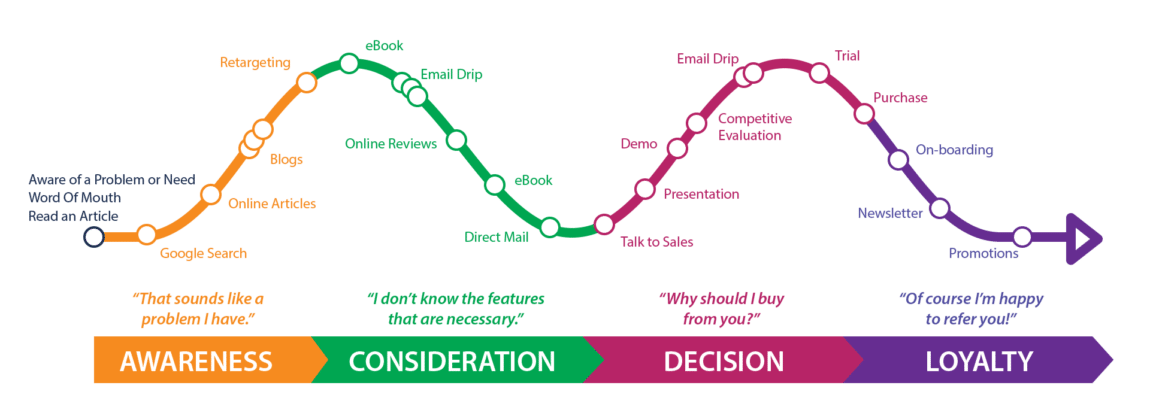Profit Potential of Integrated Direct Mail Campaigns


Digital marketers are faced with two growing challenges — digital marketing effectiveness is being reduced due to increased user privacy, and at the same time, digital advertising costs are increasing. This presents opportunities for direct mail suppliers.
However, there is an increasing number of digital-first direct mail companies. These companies sell directly to digital marketers and speak the digital marketing language.
But you can compete.
Integrate Direct Mail with Other Marketing Efforts
Put the customer first, and look at things from their perspective.
Consider all the possible touch points a customer goes through on their journey from initial awareness of a need, to learning of your company, and the steps they go through to eventually make a purchase. It always takes multiple touches on multiple channels to make a B2B sale.
Using the customer perspective, consider the steps they go through on their journey. Define marketing touches, delivered by your campaigns and programs, that help move customers along their customer journey.

These marketing channels are tools you can use to help the customer move, at their own pace, through an integrated customer journey.
- Events: physical, online, and personal 1:1 meetings
- Website: communicate value propositions, generate leads, and obtain mailing addresses.
- Digital Advertising: retarget to website visitors, or advertise printed packages.
- Email marketing: use direct mail to grow your email list.
- Phone: provide a phone number for incoming. Use call tracking numbers in the other channels to measure response.
- Direct Mail: purchase list to send awareness direct mails. Use all the above channels to promote direct mail packages such as samples, reports, and how-to guides.
Don’t think of each of the above channels as individual efforts. Think of how they nudge the customer along their journey. Read more about the customer journey in this PMC article.
Define Direct Mail Products
Don’t treat each direct mail job as a custom job.
Instead, define standard direct mail products. A product is a predefined size and folding technique of a single format, such as a postcard, self-mailer, or letter.
These predefined products provide many benefits in a direct mail program:
- Predefined layouts allow faster design and copywriting
- Standardize pricing, allowing published pricing or faster estimating
- Lower costs and faster turnaround time
To implement standard products:
- Define a design template for each mail product. Create a specific template that defines the size and placement of graphics, headlines, and copy. You can define multiple templates, with different layouts, for each product size. You can share Adobe InDesign template files with customers, or put them online using web-to-print software like XMPie.
- Define and optimize production processes that allow the products to be quickly and efficiently manufactured.
- Create standard pricing. Publish online, in sales collateral, or just use pricing tables to quickly create estimates.
- Promote your products on your website, in marketing emails, advertising, and most effectively, using send direct mail using your standard products.
These standard direct mail products allow you to compete with digital-first direct mail companies. Your customers see an apples-to-apples pricing and lead time comparison. Standard products allow you to get the conversation started, and since you don’t have the limitations of the digital-first competition you can upsell when your customer wants oranges.
Competing in a Digital World
Before the advent of digital technologies, direct mail was a mass media communications channel. The same standard message was delivered to large audiences.
Digital advertising, websites, and email provide lower-cost ways to communicate with customers.
While email is still inexpensive, digital advertising costs have risen considerably while becoming less effective. Apple has taken steps to ensure user privacy, and Google is ending support for 3rd party cookies. Both of these decrease digital advertising effectiveness.
Agencies are noticing:
“With the increase in the cost of digital marketing, somehow we landed where you can send four direct mail pieces to a targeted audience for the cost of one click.”
— Polly Wong, President, Belardi Wong — source: Retail Brew, Dec 2023“As we keep just keep seeing response rates in digital go down, click through rates keep going down, even the cost-per-acquisition [increase] and conversion rates on digital keep going down, it’s making direct mail even more competitive versus digital.”
— José Villa, President, Sensis Agency — source: Retail Brew, Dec 2023
While direct mail can solve Retail Brew, Dec 2023, don’t pitch direct mail as a replacement for email. Don’t use statistics like email marketing has a <1% response rate. Marketing emails sent to an opted-in customer list can have 30% open rates and 8% click-through rates, or higher.
Digital direct mail technologies allow deep integration with online digital marketing. Many companies that offer direct mail integration have sprung up that market directly to digital agencies and end customers.
Understand what these digital-first direct mail companies offer and how they communicate. Postalytics, PebblePost, and Lob are a few companies to understand. Once you see how they position their offerings you can learn how to compete. Or you can resell their offerings if that fits your business model.
Another effective way to compete is to add services developed for direct mail companies, such as DirectMail 2.0 and Mindfire, into your technology stack. These allow you to leverage your printing technologies while delivering integrated digital services to your customers.

Tod Cordill helps B2B companies define and implement revenue growth strategies through integrated online and offline marketing. Please provide more context or details about what you would like me to rewrite.



